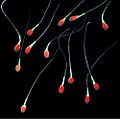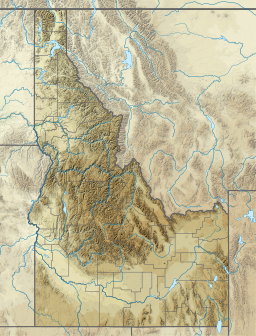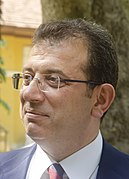운동성
Motility운동성은 신진대사에너지를 사용하여 독립적으로 움직이는 유기체의 능력이다.
정의들
신진대사에너지를 사용하여 독립적으로 움직이는 [2][3]유기체의 능력인 운동성은 자기부동의 수단이 없고 보통 움직이지 않는 유기체의 상태인 심실성과 대조될 수 있다.운동성은 물체의 이동 능력인 이동성과는 다릅니다.질이라는 용어는 운동성과 이동성을 모두 포함한다; 식물과 곰팡이를 포함한 세실성 유기체는 종종 바람, 물 또는 다른 [4]유기체와 같은 다른 매개체에 의해 분산될 수 있는 과일, 씨앗 또는 포자와 같은 질성 부분을 가지고 있다.
운동성은 유전적으로 [5]결정되지만 독소와 같은 환경적 요인에 의해 영향을 받을 수 있습니다.신경계와 근골격계는 포유류의 운동성을 [6][7][8]대부분 제공한다.
동물의 이동과 더불어, 비록 어떤 것들은 수동적인 이동으로 묘사되지만, 대부분의 동물들은 이동성이 있다.많은 박테리아와 다른 미생물, 그리고 다세포 유기체는 운동성이 있다; 다세포 기관과 조직의 유체 흐름의 일부 메커니즘은 위장 운동성과 마찬가지로 운동성의 예로 간주된다.운동성 해양 동물은 보통 자유수영이라고 [9][10][11]불리고, 운동성 비기생 생물은 [12]자유생활이라고 불립니다.
운동성은 음식을 소화관을 통해 이동하는 유기체의 능력을 포함한다.장운동성에는 연동운동과 [13]분할운동의 두 종류가 있다.이러한 운동성은 위장관 내 평활근의 수축에 의해 야기되며, 위장관 내 평활근은 다양한 분비물과 혼합되어(분열),[14] 소화관을 통해 입에서 항문까지(주변) 내용물을 이동시킨다.
셀 레벨
셀 레벨에는 다음과 같은 다양한 이동 모드가 있습니다.
- 편모 운동성, 수영과 같은 운동(예를 들어 정자에서 관찰되며 편모의 규칙적인 박동에 의해 추진되며, 또는 나선 원핵 편모를 회전시킴으로써 헤엄치는 대장균
- 아메바 운동, 기어다니는 듯한 운동, 수영도[16][17] 가능하게 하는 운동
- 활공 운동성
- 무리 운동성
- 경련 운동성, 타입 IV 필리라고 불리는 갈고리 모양의 필라멘트를 사용하여 박테리아가 표면을 기어다니기 위해 사용하는 운동성의 한 형태입니다.
- 축삭 성장[18] 원추의 이동을 가능하게 하는 필로포디아
많은 세포는 Klebsiella pneumoniae와 Shigella와 같이 운동성이 없거나 37°[citation needed]C의 Yersinia pestis와 같은 특정 상황에서 운동성이 없다.
움직임
움직임으로 인식되는 이벤트는 다음과 같이 지시할 수 있습니다.
- 화학적 구배를 따라(화성 참조)
- 온도 구배를 따라(열축 참조)
- 빛의 구배를 따라(광축 참조)
- 자기장 라인을 따라(자기축 참조)
- 전기장을 따라(아연도 참조)
- 중력의 방향을 따라(중력 참조)
- 강성 구배를 따라(듀로텍스 참조)
- 세포 접착 부위의 구배를 따라(합토택시 참조)
- 다른 세포 또는 생체 고분자를 따라
식물의 새싹은 빛을 향해 자라면서 움직인다.이것은 양성 포토트로피즘으로 알려져 있다.뿌리는 빛을 피해 자란다.이것은 네거티브 포토트로피즘으로 알려져 있다.
「 」를 참조해 주세요.
레퍼런스
- ^ Clegg, Chris (2008). "3.2 Cells make organisms". Edexcel biology for AS (6th ed.). London: Hodder Murray. p. 111. ISBN 978-0-340-96623-5.
Division of the cytoplasm, known as cytokinesis, follows telophase. During division, cell organelles such as mitochondria and chloroplasts become distributed evenly between the cells. In animal cells, division is by in-tucking of the plasma membrane at the equator of the spindle, 'pinching' the cytoplasm in half (Figure 3.15). In plant cells, the Golgi apparatus forms vesicles of new cell wall materials which collect along the line of the equator of the spindle, known as the cell plate. Here, the vesicles coalesce forming the new plasma membranes and cell walls between the two cells (Figure 3.17).
- ^ "Motility" (PDF). Retrieved 10 March 2018.
- ^ "Online Etymology Dictionary".
"capacity of movement," 1827, from French motilité (1827), from Latin mot-, stem of movere "to move" (see move (v.)).
- ^ "Botanical Nerd Word: Vagile". torontobotanicalgarden.ca/. 7 November 2016. Retrieved 29 September 2020.
- ^ Nüsslein-Volhard, Christiane (2006). "6 Form and Form Changes". Coming to life: how genes drive development. San Diego, California: Kales Press. p. 75. ISBN 978-0979845604.
During development, any change in cell shape is preceded by a change in gene activity. The cell's origin and environment that determine which transcription factors are active within a cell, and, hence, which genes are turned on, and which proteins are produced.
- ^ Fullick, Ann (2009). "7.1". Edexcel A2-level biology. Harlow: Pearson. p. 138. ISBN 978-1-4082-0602-7.
- ^ Fullick, Ann (2009). "6.1". Edexcel A2-level biology. Harlow: Pearson. p. 67. ISBN 978-1-4082-0602-7.
- ^ E. Cooper, Chris; C. Brown, Guy (October 2008). "The inhibition of mitochondrial cytochrome oxidase by the gases carbon monoxide, nitric oxide, hydrogen cyanide and hydrogen sulfide: chemical mechanism and physiological significance". Journal of Bioenergetics and Biomembranes. 40 (5): 533–539. doi:10.1007/s10863-008-9166-6. PMID 18839291. S2CID 13682333.
- ^ Krohn, Martha M.; Boisdair, Daniel (May 1994). "Use of a Stereo-video System to Estimate the Energy Expenditure of Free-swimming Fish". Canadian Journal of Fisheries and Aquatic Sciences. 51 (5): 1119–1127. doi:10.1139/f94-111.
- ^ Cooke, Steven J.; Thorstad, Eva B.; Hinch, Scott G. (March 2004). "Activity and energetics of free-swimming fish: insights from electromyogram telemetry". Fish and Fisheries. 5 (1): 21–52. doi:10.1111/j.1467-2960.2004.00136.x.
We encourage the continued development and refinement of devices for monitoring the activity and energetics of free-swimming fish
- ^ Carey, Francis G.; Lawson, Kenneth D. (February 1973). "Temperature regulation in free-swimming bluefin tuna". Comparative Biochemistry and Physiology A. 44 (2): 375–392. doi:10.1016/0300-9629(73)90490-8. PMID 4145757.
Acoustic telemetry was used to monitor ambient water temperature and tissue temperature in free-swimming bluefin tuna (Thunnus thynnus Linneaus [sic], 1758) over periods ranging from a few hours to several days.
- ^ "About Parasites". Centers for Disease Control. Retrieved 29 September 2020.
Protozoa are microscopic, one-celled organisms that can be free-living or parasitic in nature.
- ^ - eMedicine의 장운동장애 개요
- ^ Wildmarier, Eric P.; Raff, Hershel; Strang, Kevin T. (2016). Vander's Human Physiology: The Mechanisms of Body Function (14th ed). New York, NY: McGraw Hill. p. 528.
- ^ Alberts, Bruce; Johnson, Alexander; Lewis, Juian; Raff, Martin; Roberts, Keith; Walter, Peter (2008). "16". Molecular biology of the cell (5th ed.). New York: Garland Science. p. 965. ISBN 978-0-8153-4106-2.
For cells to function properly, they must organize themselves in space and interact mechanically with their environment... Eucaryotic cells have developed... the cytoskeleton... pulls the chromosomes apart at mitosis and then splits the dividing cell into two... drives and guides intracellular traffic of organelles... enables cells such as sperm to swim and others, such as fibroblasts and white blood cells, to crawl across surfaces. It exhibits wide range of movement
- ^ Van Haastert, Peter J. M. (2011). "Amoeboid Cells Use Protrusions for Walking, Gliding and Swimming". PLOS ONE. 6 (11): e27532. Bibcode:2011PLoSO...627532V. doi:10.1371/journal.pone.0027532. PMC 3212573. PMID 22096590.
- ^ Bae, A. J.; Bodenschatz, E. (2010). "On the swimming of Dictyostelium amoebae". Proceedings of the National Academy of Sciences. 107 (44): E165–6. arXiv:1008.3709. Bibcode:2010PNAS..107E.165B. doi:10.1073/pnas.1011900107. PMC 2973909. PMID 20921382.
- ^ Gilbert, Scott (2006). Developmental biology (8th. ed.). Sunderland, Mass.: Sinauer Associates, Inc. Publishers. p. 395. ISBN 9780878932504.
- ^ Parsons, Richard (2009). "Unit 5 Section 1". A2-level biology : the revision guide : exam board: Edexcel. Broughton-in-Furness: Coordination Group Publications. p. 50. ISBN 978-1-84762-264-8.
Skeletal muscle is the type of muscle you use to move, e.g. the bicep and triceps move the lower arm. Skeletal muscles are attached to bones by tendons. Ligaments attach bones to other bones, to hold them together. Skeletal muscles contract and relax to move bones at a joint.
- ^ Vannini, Vanio; Jolly, Richard T.; Pogliani, Giuliano (1994). The new atlas of the human body : a full color guide to the structure of the body. London: Chancellor Press. p. 25. ISBN 978-1-85152-984-1.
The muscle mass is not just concerned with locomotion. It assists in the circulation of blood and protects and confines the visceral organs. It also provides the main shaping component of the human form.

![Muscles give the ability for voluntary movement, and involuntary movement as in muscle spasms and reflexes). At the level of the muscular system, motility is a synonym for locomotion.[19][20]](http://upload.wikimedia.org/wikipedia/commons/thumb/1/13/Muscular_system.svg/86px-Muscular_system.svg.png)







